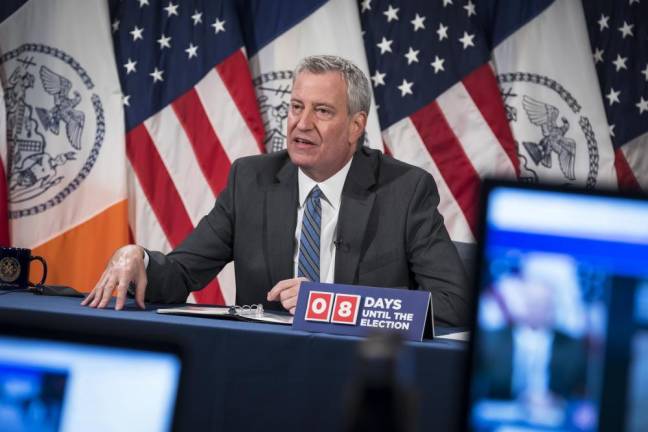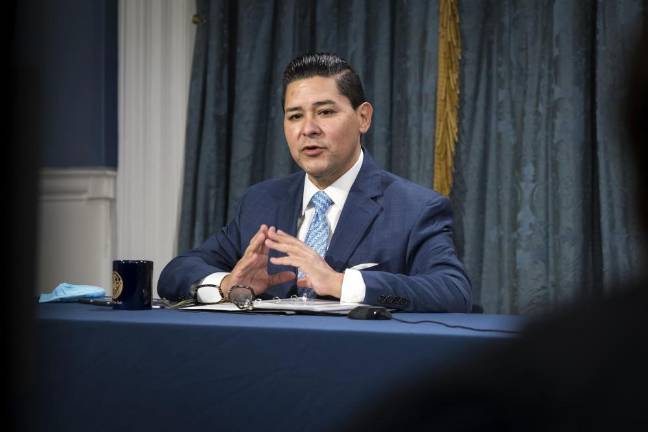New York City’s Department of Education is once again asking parents to make a big decision in a short period of time.
After initially saying families could opt in for in-person earning once a quarter, schools Chancellor Richard Carranza has changed the rules, and now parents will only have until Nov. 15 to choose a mode of instruction for their child for the rest of the school year. Carranza has said the rule change was made to help principals, who’ve had to adapt to a fluctuating student population. But in practice, the rule will certainly be a limitation for some families who hoped to employ a “wait and see” strategy for the spring.
One parent also suggested the rule change is a tactic the DOE is employing to get more children into schools after fewer students than expected have opted in for in-person learning. Only 283,000 of the 1.1. million children in the city’s public school system have attended school in person this year, according to DOE data. By comparison, the city had expected 460,000 students to opt in for in-person at the start of the year. It’s a disappointment to Mayor Bill de Blasio, who was adamant over the summer that opening schools for in-person instruction was the right thing for students.
“Given the pandemic and the extraordinary amount of upheaval, that’s not a bad number,” said de Blasio after releasing the attendance data last week. “This number is a number that needs to be understood as a work in progress ... But we want that number to go up. So, we have work to do.”
Families may find some assurance in the results from the schools’ randomized testing program, which has shown a positivity rate of just 0.15 percent, and be encouraged to send their child back into the classroom. But it’s unclear if it’s enough to coax parents to take the leap.
Alyssa Gelper, a mother to two high school sophomores, said her boys will remain learning remotely, but it’s not the choice her family had planned on making at the beginning of the school year.
Initially, Gelper said, both of her sons, who respectively attend The Clinton School and LaGuardia High School, were set to choose hybrid learning, until the DOE’s teacher shortage made that choice significantly less appealing.
Staffing Issues
During the week of orientation in September, Gelper said her son emerged from his bedroom and asked why he should bother going to school in person if the teachers weren’t going to be there.
“What? That’s not was they told us,” Gelper told her son at the time. As it turned out, Gelper said, because of the staffing issues, students would be in the classroom, but they would be watching a teacher’s instruction via a computer.
“Why should my kid have to be in a mask in a room all day — not being able to move around or socialize — and watch the same thing he could watch from his own bedroom?” said Gelper. She said her son gave it a try for one day, but ultimately decided he would be more comfortable learning remotely from home.
“I fully supported that decision because there was educational advantage and no social advantage because the kids were being separated anyway and there weren’t that many kids who were coming in,” she said.
Her son who attends LaGuardia had also planned on being in school once a week — during which time he would participate in his drama studio courses — but he also quickly realized that it wasn’t going to work out.
“It became readily apparent that like half the teachers weren’t going to be there, and the teachers didn’t want the kids there,” said Gelper. “They were going to be really restrained, you know, acting with masks on. If they were home they could at least express themselves over the computer.”
Since the DOE has not resolved its staffing issues, nothing has changed much to sway Gelper and her sons that attending school in person is the right choice for them at the moment.
Decisions Based on Health
The DOE has also not been able to convince Sharone Blonder, who is not only a mother to two elementary school boys in Chelsea, but a teacher as well, that sending her children back to school is not the right choice for her family.
Blonder received a medical exemption from her school to teach fully remotely, so sending the boys for in-person learning didn’t make sense for her and her husband.
“We’re making decisions based on our health,” said Blonder. “Obviously, there’s a lot of considerations, including mental health and social health for the kids, and making sure that they’re still getting those social interactions that they need. But our take is like, well, if someone gets sick, the rest of it really doesn’t matter.”
While Blonder acknowledged that the schools so far have had an extremely low positivity rate in their random COVID-19 testing, she said it’s hard to believe it will remain that low as the number of cases in the rest of the country continue to balloon. With all of this in mind, and the ever-evolving nature of the virus, Blonder said it is hard to know exactly when she and her husband might feel comfortable sending their children to school again.
But she said this year’s school experience can be improved for everyone if the DOE does a better job listening to educators and parents.
“I wish that the Department of Ed would listen to the people who are dealing with all of these things — to the parents, to the principals, to the teachers — who have the exact insight of what the issues are, and what would make them better,” said Blonder. “It seems like a numbers deal [to the DOE] instead of what’s best for kids, what’s best for teachers and how to keep families feeling safe.”
“Why should my kid have to be in a mask in a room all day — not being able to move around or socialize — and watch the same thing he could watch from his own bedroom?” Alyssa Gelper, high school parent

